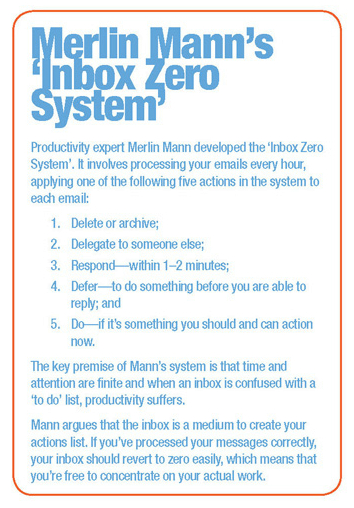Read on for the full article…
The ‘0’ Inbox
By Angeline Zaghloul for Modewest Magazine – July 6, 2015
A couple of decades ago written communication was slow. But ‘snail’ mail and fax allowed us to think about our response—and we could get things done while waiting for a reply. From the 90s onward email has taken their place. With the constant barrage of spam and marketing emails, as well as our personal and business correspondence, managing our inboxes has become a stressful task, however. “Instead of looking forward to emails”, points out Angeline Zaghloul from Peer Business Consulting in Sydney, “we’re now craving that elusive concept: the ‘zero inbox’—that state of nirvana when our inboxes are empty—and stay that way!” But is the zero inbox achievable? And how do we get there?
Despite the approximately four billion email accounts that exist worldwide today, and the average 200 emails people receive daily, email management can be achieved—and sustained—if you apply some basic and practical principles.
If your inbox is a complete mess you might have to spend some time doing an initial tidy. As you get things under control, it’s then going to be easy to implement your new system.
Tip: Be consistent and take care not to let your inbox get out of control again.
 Rule #1: Create labels or folders
Rule #1: Create labels or folders
Gmail and Outlook are both perfectly good ‘email clients’ (the software or application used to read and write emails)—and the most popular amongst business users today, replacing email clients such as Yahoo and Hotmail. Outllook has existed for ten years longer than Gmail and therefore performs in a more traditional way using a folder filing system.
In Outlook, your emails ‘live’ in different folders—that you have designated to them. The Outlook folder filing system is highly practical, and allows you to consistently file your emails away.
In Gmail, the equivalent filing system is to ‘label’ your emails. Your emails are ‘tagged’ into different labels—and the advantage of this filing system is that you can apply multiple labels to the one email. Once your emails are labelled as you wish, your emails can be archived and then recalled when you click on the tag in the left sidebar menu.
While Outlook folders may initially ‘feel’ more final, in practice the difference between Outlook folders and Gmail labels is minimal, and both constitute the first basic rule in achieving a zero inbox.
Rule #2: Don’t leave your email client open
“We all get a little excited when we see an email notification on our desktop or portable device”, notes Angeline. “But these notifications distract us from what we’re supposed to be doing and kill our productivity instantly.”
Indeed, it is our human nature to stop everything to read an incoming email and, before we know it, we’re back to trawling our inboxes and the work we were doing becomes a distant memory.
Angeline’s advice for staving off procrastination is to close your email client until you’re ready to process your emails. (Refer to Merlin Mann’s ‘Inbox Zero System’.) “At the very least,” she says, “turn off notifications of new emails.”
For Gmail users, Google Chrome has a plug-in called Inbox Pause which can be effective in stopping new emails for a period of time, without you having to exit Gmail—handy in case you still need to send emails.
 Rule #3: Compound your subscriptions
Rule #3: Compound your subscriptions
Angeline’s advice is to resist subscribing to too many blogs and email newsletters. “It’s a common mistake to subscribe to every blog and newsletter you can get your hands on,” she says, “in an effort to obtain the latest trends and useful information. But if you don’t have time to read them all, they end up clogging your inbox.
“Use Unroll.me to easily unsubscribe from the newsletters you don’t read, and roll up the others into one daily email,” she recommends.
Rule #4: Filter and file in one hit
Using ‘filters’ in Gmail or ‘rules’ in Outlook to categorise incoming emails is a great way to file emails on receipt, which you can then read later.
In Gmail you can filter emails and allow them to still remain in the inbox, therefore making it great for identifying what the email is about at a quick glance, however without the risk of forgetting about it by having it archived straight away.
In Outlook, these rules work more or less the same way as filters in Gmail. The purpose is to make categorising emails automatic based on sender, keyword or other such markers.
Caution: Be careful not to forget these emails. If you are filing away a lot of emails each day, consider deleting them instead or unsubscribing from unnecessary subscriptions.
Rule #5: Don’t forget your sent emails
Sent items can be managed in exactly the same way as your inbox emails. By default, replies to email messages in Outlook are saved in the sent folder. This behaviour can be changed in the settings, however.
Go to File > Options > Mail > Save Messages, and check the box that says, “When replying to a message that is not in the inbox, save the reply in the same folder.”
In Gmail, you can do the same thing. And, if you have labelled the incoming email and hit reply, the sent email will automatically have the label applied to it and will be archived to that label automatically when you press send.
Rule #6: Step away from the inbox
“I can’t count the number of times I’ve walked through offices and seen entire teams sitting at their computers trawling through emails”, says Angeline. “If your email doesn’t need to be documented for audit or record-keeping purposes, or if it contains staff-sensitive or client-sensitive communication—communication that would be better made face-to-face—you may be better to call the person or arrange a meeting rather than send an email.
“Every now and then,” says Angeline, “it would be wise for us all to step away from the inbox—and away from our computers, for that matter—and reconnect personally with our clients and colleagues.”
—
This article was first published in Modewest Issue 3. You can download the full issue for FREE by subscribing online at modewest.com.au.
* Images used with permission from Modewest.
—
 What did you think of this article? Post your comments and questions below. And if you found this useful, please share with your networks.
What did you think of this article? Post your comments and questions below. And if you found this useful, please share with your networks.
About the Author: Angeline Zaghloul is an expert in business strategy, client management and business processes, and is the Principal of Peer Business Consulting, a Sydney-based consultancy providing strategy and operations support to startups and SMEs. Angeline also publishes a weekly blog which provides research, advice and tips on key issues facing businesses.


Fantastic stuff!
Thanks so much for the support, Gina!